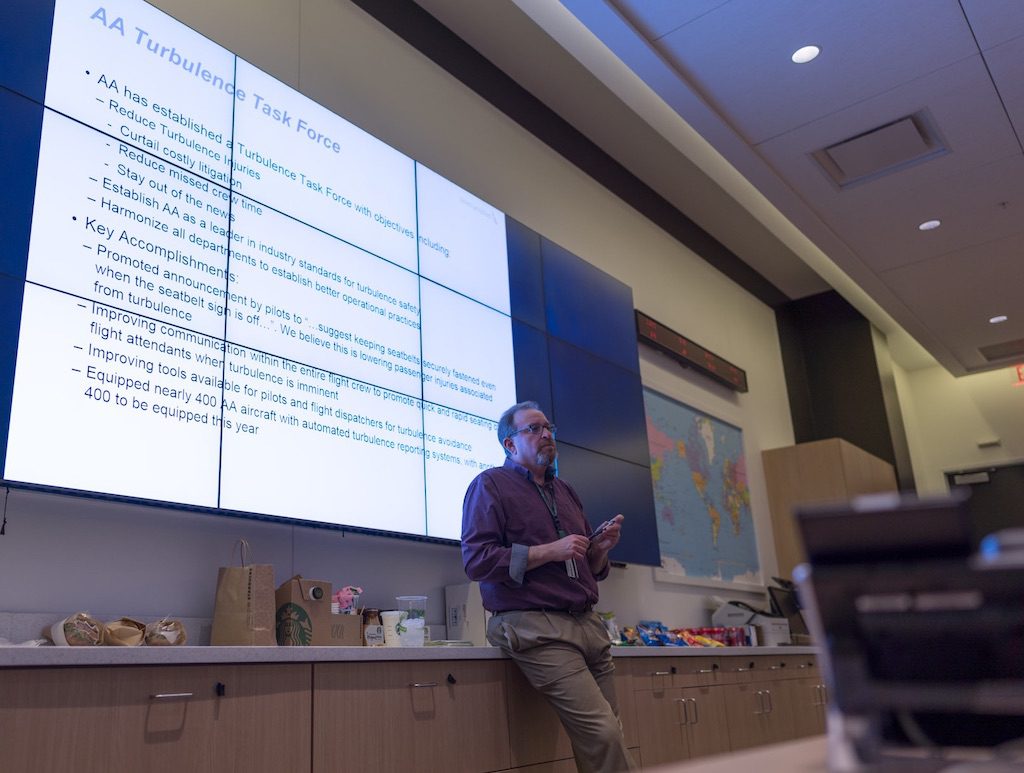Skift Take
Steve Abelman, the only meteorologist employed by American Airlines, is passionate about his craft.
 Every month Skift will profile someone working in the quirkiest, most incredible and surprising jobs in global travel. Skift's relentless curiosity about our industries extends to every corner of the labor market. Who knew jobs like this even existed?
Every month Skift will profile someone working in the quirkiest, most incredible and surprising jobs in global travel. Skift's relentless curiosity about our industries extends to every corner of the labor market. Who knew jobs like this even existed?
Steve Abelman, the only meteorologist employed by American Airlines, wants to eliminate turbulence injuries. But even with advances in science, airlines still struggle to predict when aircraft will bounce around.
“Turbulence is a very difficult, transient forecast,” he said. “Forecasts of severe turbulence are the best they’ve ever been, but the forecast of light or light-to-moderate turbulence are not as good, and light-to-moderate turbulence can be enough to injure a flight attendant who was serving from a cart. Those are still real challenging for us.”
Abelman, 54, has been in aviation meteorology for 30 years, including two stints at American, and may know more about how weather affects airplanes than anyone. The first time he worked at American, in the 1990s, Abelman forecasted weather, helping operations teams decide when to cancel, delay, or divert flights. Now, American uses an outside firm called The Weather Company for forecasts, and Abelman focuses on the bigger picture.
Increasingly, he’s the turbulence czar. Sometimes that means asking whether climate change is affecting turbulence (he’s not sure) or searching for new technology that can help American’s pilots avoid choppy air. Just as often, though, he’s more of a turbulence evangelist, reminding American’s crews about the damage unstable air can cause.
Over the years, turbulence has become less dangerous for U.S. airline passengers, because pilots usually err on the side of caution and ask customers to sit if they fear rough air. While American does not have concrete data, Abelman said he suspects passenger injuries could be near an all-time low. American usually sees customer injuries only during what he called an unexpected “big event,” when a plane is jolted while the seatbelt sign is off, and no one saw it coming.
Flight attendants are another matter. They often keep working during turbulence, and sometimes they get hurt. “We are very bothered and concerned about the number of injuries that are happening with flight attendants,” Abelman said.
It seems like an easy problem to solve. If flight attendants would sit along with passengers, they’d be safer. But it’s not so easy.
About 70 percent of American’s “significant turbulence events,” Abelman said, occur on descent, below 20,000 feet. Pilots may know it’s coming, from weather forecasts or reports from other pilots, but since the Federal Aviation Administration (FAA) mandates flight attendants make pre-landing safety checks, they must remain in the aisles.
Safety regulators have long believed the checks — that’s when flight attendants ask whether the seat in its upright position and if tray tables are stowed — outweigh the injury risk. But Abelman said American is gently lobbying the FAA to alter its rules.
“Safety wins here,” he said. “When the crew thinks there is a reason for the flight attendants to be seated, we have to get them seated. I think that’s an important change that’s coming very soon and it’s coming across the industry.”
Automated Turbulence Reporting
Since it’s challenging for meteorologists to predict turbulence, airlines also historically have relied on pilot reports to guide where aircraft will fly.
After pilots fly through rough air, they usually report to their airlines and air traffic controllers, who relay it to other airplanes. But there are a couple of issues. One, pilots can be busy, and if they’re working on another task, they may wait to make the report. Two, pilots must use specifics words — light, moderate, and severe — to describe what they feel, and since everyone defines words differently, there’s no scientific approach to data gathering.
But now, Abelman said he is excited about new automated sensors that gather turbulence information and share consistent data with flight dispatchers and pilots. American has installed them on about 400 airplanes, with 400 still to come, Abelman said.
Pilots have in-flight access to this data through their iPads, and they may seek to change their flight plan based on the sensor’s reports.
“This is all done without the pilot having to write anything down and without the pilot having to call air traffic control and without air traffic control having to relay something,” Abelman said.
American now has enough data to make better predictions in U.S. airspace. But that’s tougher on long-haul flights, since American may only serve a destination once or twice a day. Also, on the longest flights, pilots may rely on a forecast prepared before departure that could be 15 hours old.
The International Air Transport Association, or IATA, has been asking airlines to share turbulence data more liberally, and Abelman said he supports the idea.
“Internationally is where we struggle because we only have a few flights a day going at certain times of the day,” he said. “If we could get data from Japan Airlines when we fly … when we get there, we won’t have the first flight out there being the pathfinder letting us know whether it’s turbulence or not.”
Becoming American’s Weather Guy
How does someone become American’s top meteorologist?
For Abelman, it started when he was a kid. Some children obsess about sports or aviation or theater. Since he was 8, Abelman has loved the weather. “I have always been a weather geek,” he said.
He graduated from Northern Illinois in 1986 with a degree in meteorology and began working at American soon after he struck up a conversation on an airplane with one of American’s flight dispatchers. He spent about 15 years with American before leaving for other weather jobs, including a stint with the FAA. He returned in 2017 as manager of weather technology.
“I feel lucky that I have a job that is part of my hobby,” he said. “I do still get a charge out of the weather. Where I am the worst is when it comes to winter weather storms.”
Years ago, he would forecast them for American. Today, he is on the periphery, letting contractors, many of whom work inside the airline’s operations center, handle daily reports.
But colleagues who worked at American in the 1990s remind him of the old days, when they counted on him to predict the weather.
Back then, people didn’t carry phones in their pockets with hour-by-hour weather predictions, so Abelman would speak on intercom at American Airlines’ operations center to share that day’s forecast. Each time, before he started, the public address system would ding to announce his presence. It would ding again when he finished.
One day, about 25 years ago, Abelman went to the microphone to tell his colleagues he expected calm weather for Dallas/Forth Worth International nearby, even if it might rain elsewhere in the region. “When I hit the second ding-dong to end it, a huge clap of thunder shook the whole building,” he said.
Even now, his colleagues laugh about the moment, though his forecasts were accurate more often than not.
“It’s a tough field,” he said.
The Daily Newsletter
Our daily coverage of the global travel industry. Written by editors and analysts from across Skift’s brands.
Have a confidential tip for Skift? Get in touch
Tags: airlines, american airlines, at your service, climate change
Photo credit: Steve Abelman, manager of weather technology at American Airlines, wants to reduce injuries from turbulence. Andy Luten / Andy’s Travel Blog
